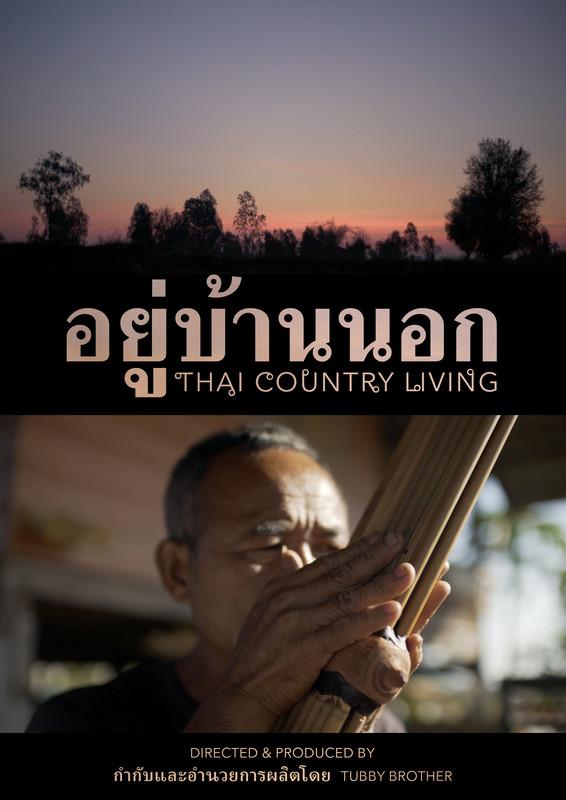Thai Country Living, a short film documentary released in 2020, is a delightful sojourn into the rural life of khaen maker Suman "Chang Bour" Tapkham, his family and village in the peaceful backwaters of the Isan region.

Thai Country Living poster
Directed by Tubby Brother for the UK-based media agency Tubby Brother Films, the 15-minute film has garnered a number of festival awards, and was a shortlisted finalist for the Canada Shorts Film Festival in 2020. Joe Cummings, former Lonely Planet compiler, did the research.
There aren't many international films on khaen makers, and in fact, not too many on Thai traditional music either. In recent years I can only think of Y/Our Music, a full-length UK/Thai film directed and produced by Waraluck Hiransrettawat Every and David Reeve, which focuses on nine different Thai musicians, including master khaen player Sombat Simlar.
The khaen, of course, is the iconic instrument for ethnic Lao on both sides of the Mekong River, that is in both Thailand and the Lao PDR. It is the National Instrument of Laos and the iconic instrument of Isan (although the three-stringed phin, the Isan, lute is more popular with young musicians learning Isan music).
There are many similar instruments in Southeast Asia, especially in the region's many tribal groups, and further afield, East Asia, China, Korea and Japan have different versions of what is known as a free-reed mouth organ. In Southeast Asia (and all the way to Bangladesh) the instrument is usually made from bamboo, while in East Asia the instrument is made from metal. The earliest evidence we have of a free-reed set of pipes is from pottery shards at funeral sites in China that date back to 400 BC. These instruments probably led to the development of free-reed instruments in the West like the accordion, concertina and harmonica.
The aim is the same for all these instruments be they a barrel-type set of pipes or, like the khaen, a raft-style set of pipes: air is blown over metal reeds which are set in each pipe. The pipes vibrate, which produces a sound. But what marks out the khaen as different to all the others is the fact that none of the reeds are stopped, ie plugged. They remain open, giving the instrument great flexibility.
The blurb for the film says it is about Suman's life and commitment to "the traditional ways of country living… far away from Bangkok" (indeed, the film begins with Suman gazing over his rice fields while saying that he was born in a different time). The blurb continues: "Suman is an important part of village life -- with the instruments he makes being essential in celebrations, get togethers, birthdays and drinking sessions."
Beautifully photographed, the film presents Suman's life as a farmer and khaen maker, using his own words and descriptions. He describes how he got into the khaen-making business through his father and how he is trying to teach his son to take over the family business but, and this is something I was told by another khaen maker, it is difficult to get young people interested in what is a difficult and very time-consuming job.
A khaen maker must be a carpenter (he must select bamboo not older than one year, or it cracks, and Thailand no longer produces this bamboo, it must be sourced from Laos); a materials specialist (beeswax to stop up the holes); a cold forger (making the metal reeds, or "tongues" in Thai, from old coins); an acoustic expert (all tuning is done by ear); and a player. This is a highly skilled craft that takes years to hone and develop.
Suman is photographed making khaens, in most of the processes involved -- and, yes, that is an elephant's thigh bone, which is used to straighten and flatten the metal reeds. One tool not shown in the film but unique to khaen-making is the "monkey-claw", an attachment that is used to ensure that the reeds are ramrod straight.
The film's climax is the nightly get-together at Suman's house where villagers and visitors gather to eat and drink and play the khaen. Everyone gets a go at playing and village elders show, often in a hilarious manner, young ones how to make a decent sound. There is a lot of good-natured ribbing and fun. This certainly had me reminiscing about Isan village life, something I experienced in the 1990s when I lived in Buri Ram. I highly recommend the film.
It is great to see a film about the master craftsmen who make the khaen because most attention is on the players not the makers. As Suman says there aren't so many makers around these days and those left are in their 60s and 70s. After I wrote about the history of the khaen for a UK magazine some years ago I got the idea of trying to persuade my Thai colleagues and friends to set up a vocational course at a college (either at a dramatic arts institute or a vocational college) in Isan to teach a course on how to make khaens. Everyone thought it was a good idea, but nobody would make a move to start the process. To me, it is a must that these master craftsmen are given their due and are given the resources and facilities to pass this precious knowledge on to the next generation.
More information on the documentary at tubbybrother.co.uk/work/thai-country-living-full-film.
John Clewley can be contacted at clewley.john@gmail.com.
